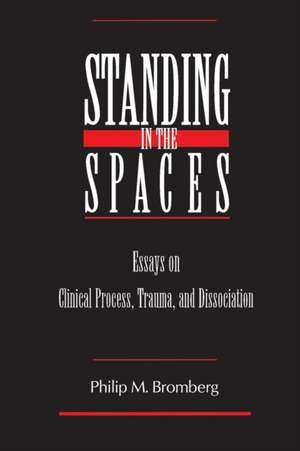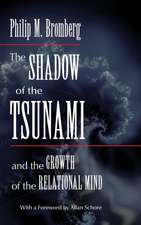Standing in the Spaces: Essays on Clinical Process Trauma and Dissociation
Autor Philip M. Brombergen Limba Engleză Paperback – iul 2001
This insight leads to other discoveries. Beneath the dissociative structures seen in schizoid patients, and also in other personality disorders, Bromberg regularly finds traumatic experience -- even in patients not otherwise viewed as traumatized. This discovery allows interpersonal notions of psychic structure to emerge in a new light, as Bromberg arrives at the view that all severe character pathology masks dissociative defenses erected to ward off the internal experience of trauma and to keep the external world at bay to avoid retraumatization. These insights, in turn, open to a new understanding of dissociative processes as intrinsic to the therapeutic process per se. For Bromberg, it is the unanticipated eruption of the patient's relational world, with its push-pull impact on the analyst's effort to maintain a therapeutic stance, that makes possible the deepest and most therapeutically fruitful type of analytic experience.
Bromberg's essays are delightfully unpredictable, as they strive to keep the reader continually abreast of how words can and cannot capture the subtle shifts in relatedness that characterize the clinical process. Indeed, at times Bromberg's writing seems vividly to recreate the alternating states of mind of the relational analyst at work. Stirringly evocative in character and radiating clinical wisdom infused with compassion and wit, Standing in the Spaces is a classic destined to be read and reread by analysts and therapists for decades to come.
Preț: 387.45 lei
Nou
Puncte Express: 581
Preț estimativ în valută:
74.14€ • 77.61$ • 61.34£
74.14€ • 77.61$ • 61.34£
Carte disponibilă
Livrare economică 15-29 martie
Livrare express 04-08 martie pentru 35.12 lei
Preluare comenzi: 021 569.72.76
Specificații
ISBN-13: 9780881633566
ISBN-10: 0881633569
Pagini: 376
Ilustrații: black & white illustrations
Dimensiuni: 152 x 229 x 25 mm
Greutate: 0.52 kg
Ediția:Revised
Editura: Taylor & Francis
Colecția Routledge
Locul publicării:Oxford, United Kingdom
ISBN-10: 0881633569
Pagini: 376
Ilustrații: black & white illustrations
Dimensiuni: 152 x 229 x 25 mm
Greutate: 0.52 kg
Ediția:Revised
Editura: Taylor & Francis
Colecția Routledge
Locul publicării:Oxford, United Kingdom
Public țintă
Professional and Professional Practice & DevelopmentNotă biografică
A preeminent writer on the understanding of trauma and dissociative phenomena, Philip M. Bromberg, Ph.D., is author of Standing in the Spaces: Essays on Clinical Process, Trauma, and Dissociation (Analytic Press, 1998), Awakening the Dreamer: Clinical Journeys (Analytic Press, 2006), and The Shadow of the Tsunami: and the Growth of the Relational Mind (Routledge, 2011). He is Training and Supervising Analyst, William Alanson White Institute, and Adjunct Clinical Professor of Psychology, New York University Postdoctoral Program in Psychotherapy and Psychoanalysis. Emeritus Co-Editor of Contemporary Psychoanalysis, Dr. Bromberg serves on the editorial boards of Psychoanalytic Dialogues and Psychoanalytic Inquiry. He lectures widely, and is actively involved in the training of mental health professionals nationally and internationally.
Cuprins
Chapter 1 Introduction; Part 1 Views from the Bridge; Chapter 2 Artist and Analyst1.This chapter was first presented in an earlier version as part of a symposium on “Learning, Practicing, and Teaching Psychoanalysis” at the Spring Weekend Conference of the William Alanson White Psychoanalytic Society in April 1990, and was published in its present form in Contemporary Psychoanalysis, 1991, 27:289–300. (1991); Chapter 3 Interpersonal Psychoanalysis and Regression1.An earlier version of this chapter was first presented at a symposium held at the Institute for Contemporary Psychotherapy, New York City, in December 1977, and was published in its present form in Contemporary Psychoanalysis, 1979, 15:647–655. (1979); Chapter 4 Empathy, Anxiety, and Reality: A View From the Bridge1.This chapter was originally published in Contemporary Psychoanalysis, 1980, 16:223–236. (1980); Chapter 5 Getting into Oneself and Out of One’s Self; Chapter 6 The Use of Detachment in Narcissistic and Borderline Conditions1.An earlier version of this chapter was presented at the 22nd Annual Meeting of the American Academy of Psychoanalysis, Atlanta, Georgia, in May 1978, and was published in its present form in The Journal of the American Academy of Psychoanalysis, 1979, 7:593–600. (1979); Part 2 Safety, Regression, and Trauma; Chapter 7 The Mirror and the Mask; Chapter 8 On the Occurrence of the Isakower Phenomenon in a Schizoid Patient1.An early version of this chapter was presented to the William Alanson White Psychoanalytic Society as the Presidential Address, May 1984. It was published in Contemporary Psychoanalysis, 1984, 20:600–624, and then revised (in the form presented here) as a chapter in Relational Perspectives in Psychoanalysis, edited by N. J. Skolnick and S. C. Warshaw (Hillsdale, NJ: The Analytic Press, 1992, pp. 257–279). (1984); Chapter 9 The Difficult Patient or the Difficult Dyad?1.An early form of this chapter was presented at a William Alanson White Institute clinical symposium, “Interpersonal Frontiers in Psychoanalytic Practice,” in November 1990. The present version was originally published in Contemporary Psychoanalysis, 1992, 28:495–502. (1992); Chapter 10 On Knowing One’s Patient Inside Out; Chapter 11 Interpersonal Psychoanalysis and Self Psychology; Part 3 Dissociation and Clinical Process; Chapter 12 Shadow and Substance; Chapter 13 Psychoanalysis, Dissociation, and Personality Organization1.This chapter revises and expands the original version of the essay published in Psychoanalytic Dialogues, 1995, 5:511–528. (1995); Chapter 14 Resistance, Object Usage, and Human Relatedness1.Portions of this essay in earlier versions were presented in February 1993 as a discussion of Christopher Bollas’s paper “Preoccupation Unto Death” at a meeting of the William Alanson White Psychoanalytic Society and as part of a November 1993 panel, “Resistance: Obstacle or Steppingstone?” at the William Alanson White Institute’s Fiftieth Anniversary Clinical Conference. The chapter was originally published in its present form in Contemporary Psychoanalysis, 1995, 31:163–192. (1995); Chapter 15 Hysteria, Dissociation, and Cure; Part 4 Standing in the Spaces; Chapter 16 “Speak! That I May See You”; Chapter 17 Standing in the Spaces; Chapter 18 Staying the Same While Changing; Chapter 19 “Help! I’m Going Out of Your Mind”1.An early version of this chapter was presented in June 1997 as part of a panel, “Perspectives on Relational Psychoanalysis” (with Lewis Aron and Adrienne Harris), sponsored by the Institute of Contemporary Psychoanalysis, Los Angeles, CA.;
Recenzii
"Philip Bromberg's essays on psychoanalysis are unique jewels that derive from the convergence of two strikingly different sensibilities. On the one hand, Bromberg is an interpersonal analyst par excellence, with a plain-speaking forthrightness, a finely honed sense of the mutual impact of people upon each other, and a distaste for the abstractions of theorizing. On the other hand, he has a keen appreciation of the mostly deeply private domains of experience, the hidden recesses, the nuances of 'innerness' within which personal existence is preserved. This combination has generated a unique vision and finely textured conceptualization of the psychoanalytic process that captures, with both wit and warmth, some of its deepest contrasts: sameness and difference, safety and growth, the emotional contacts that make a deeply personal life possible and the immutably private. Standing in the Spaces makes available a body of work that is one of the finest achievements of contemporary pychoanalysis." - Stephen A. Mitchell, Ph.D., Author, Relationality (Analytic Press, 2000)
"Setting out to solve the riddle of meaning formation and therapeutic leverage, Bromberg presents a vivid and compelling new picture of the mind as more tenuously integrated than we had thought - a paradigm that sheds so much light on clinical phenomena and on the margin available for change that conflict theorists simply cannot ignore it. But Bromberg's greatest service is to reveal the high, technical dignity of those powerful forces that practitioners sensed in their bones but scorned as nonspecific and ungovernable, now orienting us to a more respectful and less impatient use of them. I predict that the impact of Bromberg's book will remain with the reader in every subsequent clinical encounter and rescue him in times of trouble." - Lawrence Friedman, M.D., Clinical Professor of Psychiatry, Weill Medical School, Cornell
"Every psychoanalyst and psychotherapist should read Standing in the Spaces in order to achieve a full understanding of what it is they do every day. The scholarship is remarkable; the style elegant and readable; the content imaginative, original, and wide-ranging; the clinical presentations tremendously evocative. The book is written from a predominantly interpersonalist perspective, but is masterly in the way it gathers in a wide range of ideas from other psychoanalytic orientations and beyond. Philip Bromberg is clearly an exceptionally gifted clinician as well as one of the outstanding theorists of our time." - Peter Fonagy, Ph.D., Freud Memorial Professor, University College London
"Setting out to solve the riddle of meaning formation and therapeutic leverage, Bromberg presents a vivid and compelling new picture of the mind as more tenuously integrated than we had thought - a paradigm that sheds so much light on clinical phenomena and on the margin available for change that conflict theorists simply cannot ignore it. But Bromberg's greatest service is to reveal the high, technical dignity of those powerful forces that practitioners sensed in their bones but scorned as nonspecific and ungovernable, now orienting us to a more respectful and less impatient use of them. I predict that the impact of Bromberg's book will remain with the reader in every subsequent clinical encounter and rescue him in times of trouble." - Lawrence Friedman, M.D., Clinical Professor of Psychiatry, Weill Medical School, Cornell
"Every psychoanalyst and psychotherapist should read Standing in the Spaces in order to achieve a full understanding of what it is they do every day. The scholarship is remarkable; the style elegant and readable; the content imaginative, original, and wide-ranging; the clinical presentations tremendously evocative. The book is written from a predominantly interpersonalist perspective, but is masterly in the way it gathers in a wide range of ideas from other psychoanalytic orientations and beyond. Philip Bromberg is clearly an exceptionally gifted clinician as well as one of the outstanding theorists of our time." - Peter Fonagy, Ph.D., Freud Memorial Professor, University College London
Descriere
In this celebrated collection of his writings, Bromberg expounds the view that severe character pathology, by its very nature, masks dissociative defenses that ward off the internal experience of trauma and keep the external world at bay. These ins










